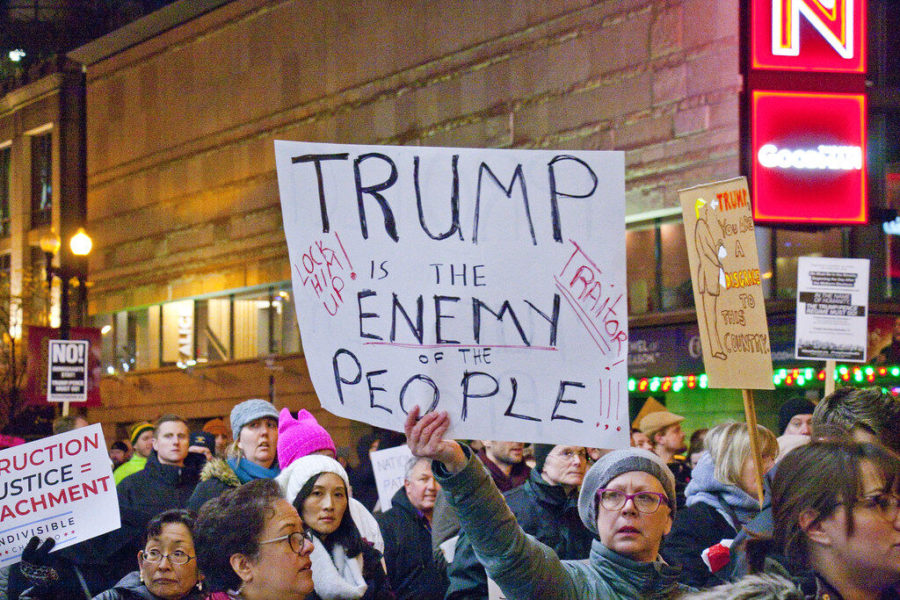Letter: The reality in Portland
Letter writer Josh Treu responds to Jake Brown’s column concerning Portland, reciting the events at hand.
July 27, 2020
This is a direct response to the Jake Brown column, “Trump should not have sent federal troops.”
The framing of this column is strange to me, from the very first paragraph, “The Trump administration’s decision to send federal law enforcement in response to protests in Portland, Oregon, is wrong and completely inappropriate. The only purpose it serves is to further escalate violence in the city, and the decision corrodes democracy and makes for bad and ineffective law enforcement,” the stage is set up sideways. Calling what has been happening in Portland, Oregon, a “protest” is as much a lie as saying the purpose of the law enforcement is escalation.
A little background on what has been happening in Portland:
At the end of May 2020, there were indeed protests going on in the response to George Floyd’s death. During the first hour or two, as far as I can tell, gatherings were peaceful and maintained their protest status protected by the First Amendment.
At around 11 p.m. May 29, people started smashing windows and destroying property. I am not condemning the whole group based on the wrongdoings of a few people.
Violence started breaking out in interactions between police and protesters the evening of the 29th. I do not condone the use of force against people acting peacefully. In the moment though, it can be hard for law enforcement to know who is peaceful and who will become violent. Around this time I believe the situation turned into a riot.
On May 31, up to 10,000 people rallied at Laurelhurst Park in violation of the curfew that had been in place. Police showed up in response, but quickly left because of the size of the crowd. This crowd marched through Portland and eventually surrounded the Justice Center demanding officers take off their protective riot gear and take a knee. After a while, the crowd dispersed and police started trying to round people up.
Instances like these continued into the month of June with participants occupying chunks of the highway and marching around downtown. During this time, there were people still peacefully protesting, but there were also belligerents rioting throughout downtown around the courthouse and Justice Center.
Interactions between Portland Police and the rioters continued throughout the month of June, with rioters throwing rocks, bottles and shooting fireworks at officers and officers retaliating with gas and batons.
At the end of June, hundreds of activists attempted to set up their own autonomous zone in the North Precinct before being forced out by police. During this time, rioters destroyed statues, including those of Thomas Jefferson and George Washington, and police escalated their response by officially declaring some gatherings as riots through the justification of likely criminal activity in the crowds.
The behavior of the Portland Police Department (PPD) understandably aggravated residents as some were locked out of their homes and apartments, forcing them to be swept up in the turmoil. Several members of the PPD have been taken to court for their maltreatment of people during this time, including the arrest of reporters.
As a response to the behavior of the PPD, U.S. District Judge Michael H. Simon issued an order banning the police from using force and arresting people. Because of this, rioters had little to no resistance to assemble around the Justice Center and courthouse.
This is where the federal agents started to come in to play. On the Fourth of July, close to 40 consecutive days of protests culminated around the federal courthouse where rioters were launching commercial fireworks at federal agents inside the building. While these wouldn’t do much to the building, it resulted in injuries to its occupants.
Rioters continued their escalation, trying to start the plywood protecting the building on fire, forcing the agents in the building to come out and push back with batons and crowd control devices. Federal agents were beaten back into the courthouse earlier this week, with a crowd of around 2,000 people tearing open the doors and beating agents further into the building.
I disagree with some of the tactics used on both sides of this conflict, but claiming what has happened as one-sided is wrong. The federal agents going out into the streets and picking up people for questioning does have dangerous potential, but knowing why they are doing it and what they are doing is important.
Unmarked vehicles are likely used because rioters attacked and destroyed marked ones and concealing identities is being done as well. Both federal and local officers have been hiding names and identifying information from rioters and protesters from fear of doxing. I do not like how these officers have hidden their identities because I believe accountability is important, but I understand why they are hiding them.
“Peaceful protests only grew in response to the federal show of force” is a lie. Claiming officers are patrolling major cities and picking up protestors simply because there is a federal building in the area is also a lie.
I cannot stress enough that I do not like the idea of anonymous federal agents “black bagging” random people, but this is not the case in Portland. You don’t get to put your hand in a fire and get mad when you’re burned. If you’re near a riot and dressed like rioters, you might be looked at as a rioter. Have some personal accountability and understand actions cause reactions, and just because you know your intent does not mean others involved know.
Josh Treu is a junior in construction engineering.







